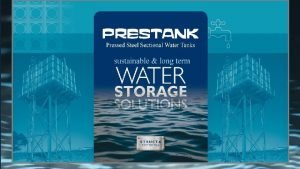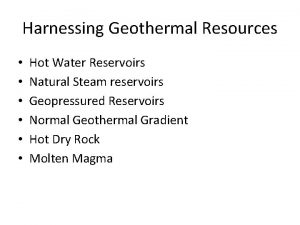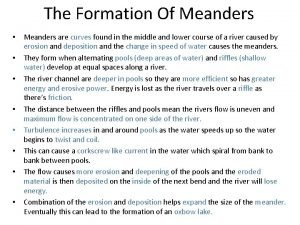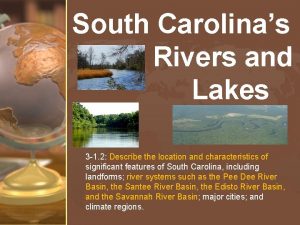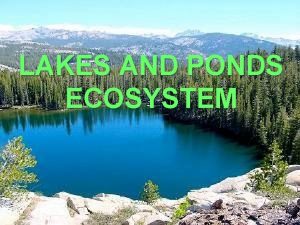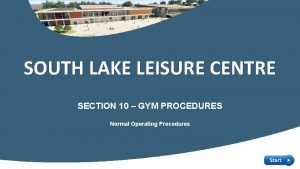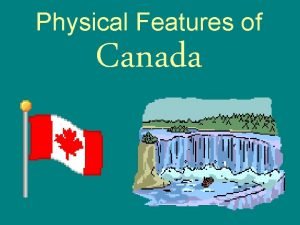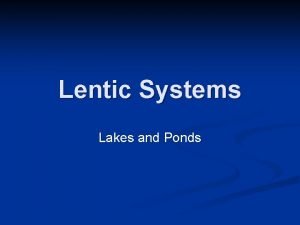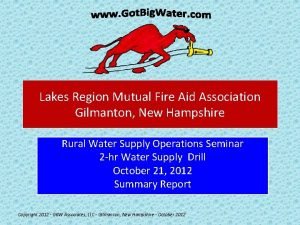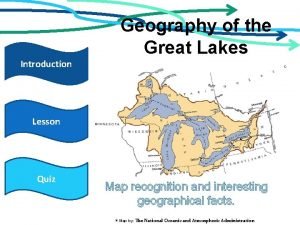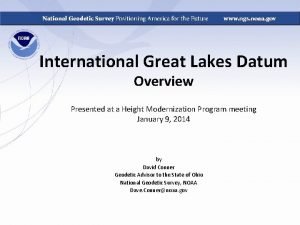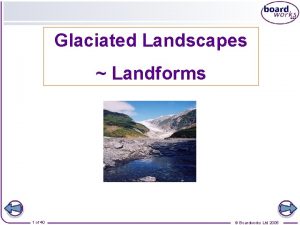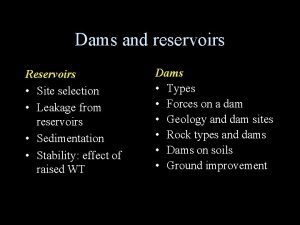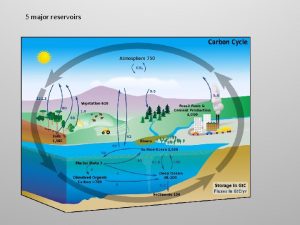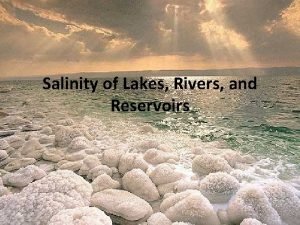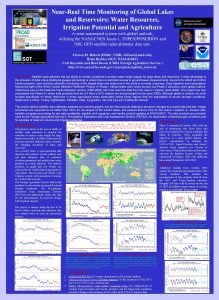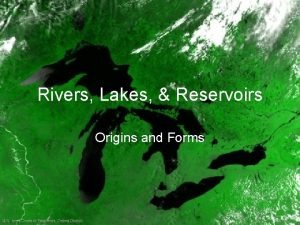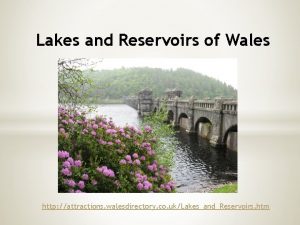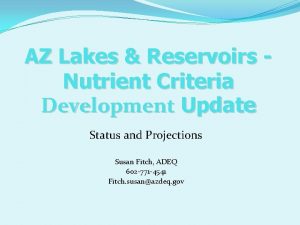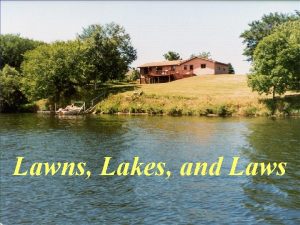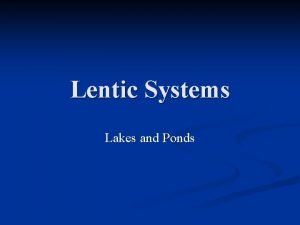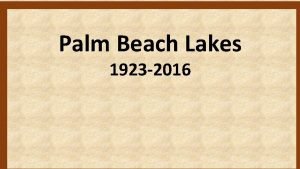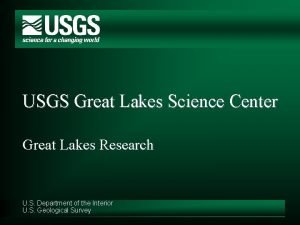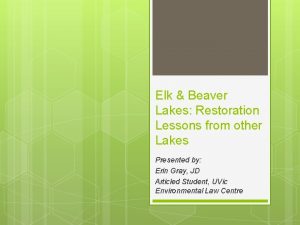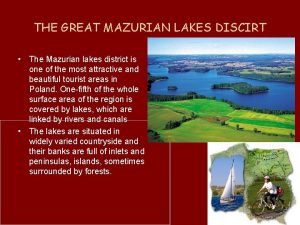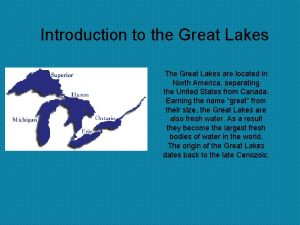3 3 Lakes and reservoirs 1 3 3





















- Slides: 21

- 3. 3 Lakes and reservoirs 1

3. 3. Lakes and Reservoirs Chapter 7 in Book Chapman Tamara Avellan Peter Kelderman UNESCO-IHE Institute for Water Education Online Module Water Quality Assessment 2

CONTENTS 1. General characteristics of lakes 2. Importance of lakes 3. Monitoring 3

Origins Oxbow lakes, Nicaragua Caldera lake, Nemrut Dag Turkey Glacier lakes, Lake Michigan 4

Origins 2 Rift lakes, Lake Tanganyika Salt lakes, Aral Sea (May (with wildfires May 2004) 2009) http: //earthobservatory. nasa. gov/IOTD 5

Importance of sunlight 6

Temperature profiles } } } Epilimnion Metalimnion/ Thermocline Hypolimnion 7

Thermal stratification Dimictic lake Stratifies/mixes twice per year T< 4 o. C (winter); >4 o. C (summer) - changes in surface water (epilimnion) temperature throughout the year (in temperate climates) - temperature remains about constant in profundal zone (hypolimnion) - during spring and fall turnover, thermocline gets disrupted and temperatures of epi- and hypolimnion are = 8

CONTENTS 1. General characteristics of lakes 2. Importance of lakes 3. Monitoring 9

Represa Rincon del Bonete in the Rio Negro reservoir, Uruguay Catchment area 40. 000 km 2 Total volume (80 m height) 8. 800 hm 3 Production 160 MW Constructed in the years 37 -48! Renovated in the 1990’s 10

Orchards Michigan has over 1, 100 fruit farms which grow apples and the state has about 8. 5 million apple trees on aprox. 20. 000 hectares On Lake Constance, Germany, about 1, 600 fruit growers cultivate about 7, 400 hectares. Yearly about 220, 000 tons pomaceous fruits are produced for the fruit trade. Do you have an example from your region, where the lake effect is the cause for extensive apple (or other fruit) production? 11

Fishing: Blessing or (Darwin’s) Nightmare 12

CONTENTS 1. General characteristics of lakes 2. Importance of lakes 3. Monitoring 13

MONITORING STATIONS • Also here preliminary surveys are very important : Bathymetry (depth contours); research on (in)homogenity number of stations. Also overall sediment mapping. Guiding principle: one station per “homogeneous area”; for well-mixed lakes: one station may be sufficient ! Generally more stations in case of: • Large and/or irregular lakes • Large variations in water depth and sediment composition Also dependent on monitoring objectives, e. g. : • Input/output budget • (one-time) research on impacts of pollution sources 14

Bathymetry 15

Example: Satelite image chlorophyll-a in “IJsselmeer” (Central Lake) in the Netherlands (red > yellow>green>blue) High spatial variation more locations Location

Algae produce O 2 during day; and consume at night Dissolved oxygen (DO) often >100 % during the day, and near zero at night • So in case of eutrophication: • Large DO variations over day/night • Also: high p. H values (up to p. H >10) during day-time always monitor a station at about the same time of day (and, of course, note down time of sampling/field analysis !) 17

Thermal stratification in “deep” lakes in summer Stratification: anaerobic conditions hypolimnion sediment release of nutrients, etc. enhanced phosphate, ammonia, H 2 S, CO 2 , etc. levels. Monitoring: epilimnion + hypolimnion + 1 m above and/or below thermocline. 18

Example: oxygen deficiency at the bottom of Lake Grevelingen, Netherlands Stratification: oxygen deficiency not visible by standard measurement at water surface 19

RESERVOIRS • Often multipurpose: water extraction, power generation, drinking water extraction, . . • Generally more stations needed than for lakes; sampling stations in all three zones: • Riverine zone: most polluted, high TSS • Lacustrine (lake) zone: least polluted • Transition zone 20

OPTIMIZATION OF MONITORING De. Gray lake, USA: 15 5 stations 21
 Pressed steel water tank
Pressed steel water tank Hot water reservoirs
Hot water reservoirs Meander
Meander South carolina major rivers
South carolina major rivers Lakes and ponds ecosystem
Lakes and ponds ecosystem How are meanders formed
How are meanders formed Great lakes scrip
Great lakes scrip Great lakes depth comparison
Great lakes depth comparison I saw susie sitting in a shoe shine shop
I saw susie sitting in a shoe shine shop Gym south lake
Gym south lake Great lakes connected to ocean
Great lakes connected to ocean Pegword method
Pegword method Sandia lakes
Sandia lakes Lentic lake
Lentic lake Lakes region mutual aid
Lakes region mutual aid Lakes in hungary
Lakes in hungary Brenntag leduc
Brenntag leduc Great lakes quiz
Great lakes quiz International great lakes datum
International great lakes datum Great lakes literacy principles
Great lakes literacy principles Drumlin
Drumlin Finger lakes formation
Finger lakes formation
